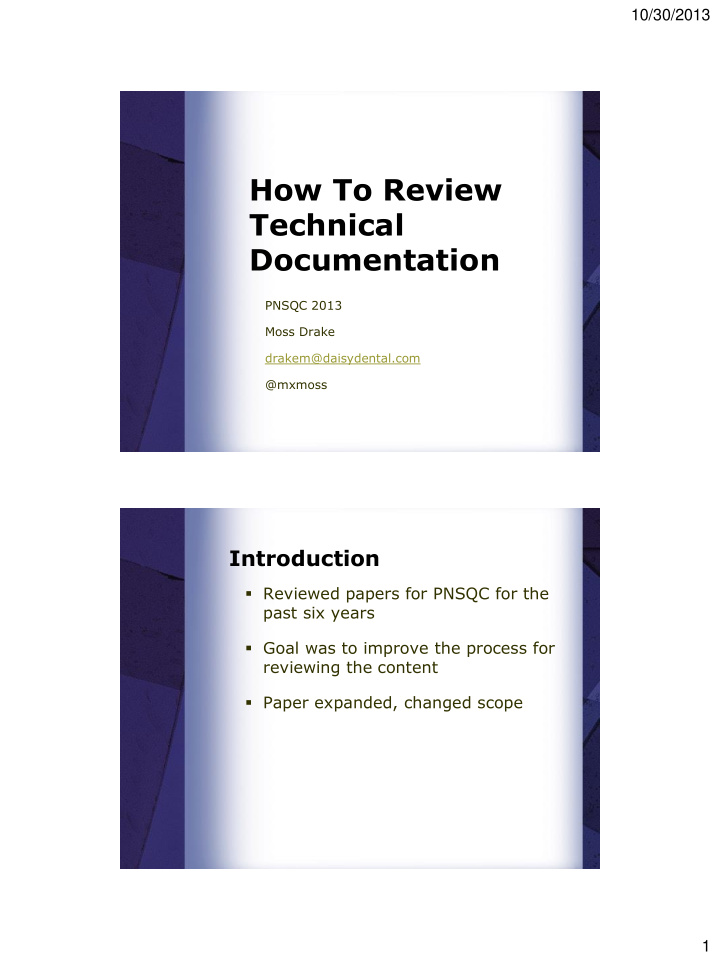



10/30/2013 How To Review Technical Documentation PNSQC 2013 Moss Drake drakem@daisydental.com @mxmoss Introduction Reviewed papers for PNSQC for the past six years Goal was to improve the process for reviewing the content Paper expanded, changed scope 1
10/30/2013 2007 A Tool to Aid Software Practitioners in Selecting a Best-Fit Project Methodology Introduction to Risk Management Facilitating Effective Retrospectives 2008 Ensuring Software Quality for Large Maintenance Releases Collaboration between Theorists – Analyze This! Collaborative Techniques for the Determination of a Best Alternative in a Software Quality Environment 2009 New Challenges to Quality in the 24x7 Enterprise I.T. Shop Reconfiguring the Box Retrospective Analysis and Prioritization Areas for Beta Release Planning Improvement Where are You in Usability? 2010 ATDD in Scrum Software Quality Assurance in the Physical World User Experience Grading via Kano Categories 2011 Sabotaging Quality Design For Delight applied to Software Process Improvement Testing in Production: Enhancing development and test agility in Sandbox environment An Introduction to Customer Focused Test Design 2012 Cultural Intelligence: From Buzz Word to Biz Mark Avoiding Overkill in Manual Regression Testing Lightweight Software Process Assessment and Improvement Using Metrics to Drive Customer Satisfaction 2
10/30/2013 The Role of Editing That's not writing, that's typing. Truman Capote The Role of an Editor ● Provides an initial audience ● Verifies communication ● Helps develop ideas ● Acts as a thoughtful critic 3
10/30/2013 The Editing Process Content and comprehension Style Copy Ground Rules ● Keep it constructive ● Evaluate the writing, not the writer ● Be specific ● Guide the writing process without obstructing the author’s voice ● Establish a dialogue 4
10/30/2013 Editing for Content Don’t get it right, just get it written. James Thurber Editing for Content ● Can I understand the paper? ● Will it make sense to the audience? ● Does it flow logically? ● Does it seem complete? ● Do all sections apply to the main topic? ● Is there enough supporting evidence or real-world examples? 5
10/30/2013 General Structure Outline the Paper Write an outline using the rules • Parallelism • Coordination • Subordination • Division Use your own words Focus on the meaning of each paragraph 6
10/30/2013 Check for Scope Creep Check for Focus 7
10/30/2013 Check for Missing Sections Check for Detail 8
10/30/2013 Check for Comprehension Use the outline to echo back to the author your takeaway The single biggest problem in communication is the illusion that it has taken place. George Bernard Shaw Editing for Style The difficulty is not to write, but to write what you mean, not to affect your reader, but to affect him precisely as you wish. Robert Louis Stevenson 9
10/30/2013 Editing for Style Style is... Voice Audience Language Consistency Flow Engagement Editing for Style 10
10/30/2013 Voice and Audience If this sentence were in Chinese, it would say something else. via Douglas Hofstadter Voice and Audience First person: “Often I copy and paste the article into a different word processor to get a second opinion.” Third person: “Copying the the article into a different word processor is a way to get a second opinion.” 11
10/30/2013 Voice and Audience ● Gauge the level of understanding that the reader brings to the table ● Define acronyms ● Trim jargon Voice and Audience ● “Test Driven Development (TDD) is a software development process that relies on the repetition of a very short development cycle.” ● “Pokémon exception handling” is “when you just gotta catch 'em all, i.e.: all exceptions must be caught.” 12
10/30/2013 Clean and Consistent ● Maintain a consistent verb tense ● Use the active voice to make writing more dynamic ● Put statements in positive form. ● Omit needless words Clean and Consistent “It is always good to explain the editing process so the author knows there are further steps.” “Prepare the author for further steps.” 13
10/30/2013 Clean and Consistent Substitute 'damn' every time you’re inclined to write 'very'; your editor will delete it and the writing will be just as it should be. Mark Twain Clean and Consistent ● Easier to understand ● More engaging ● Gives authority to the writing 14
10/30/2013 Copy Editing Punctuation Saves Lives: Let's eat Grandma. Let's eat, Grandma. Copy Editing 15
10/30/2013 Copy Editing Copy Editing Print the article to see it differently Read it aloud Try reading the text back to front to remove context and see only grammar Give the article to a new audience Allow time for multiple passes 16
10/30/2013 Copy Editing Lessons Learned I hate writing, I love having written. Dorothy Parker 17
10/30/2013 Lessons Learned Editing is an integral part of the writing process Editing is a dialog Takes time Details matter The result is rewarding References Bowman, D. (2012). Concise Guide to Technical and Academic Writing. Amazon Digital Services, Inc. . Modern Language Association. (2009). MLA Handbook for Writers of Research Papers, 7th Edition . Modern Language Association of America. Profeta, S. (n.d.). DAISY Master Checklist. Portland, Oregon, USA: Tiger Heron LLC. Staff, U. o. (2010). The Chicago Manual of Style, 16th Edition . Chicago: University Of Chicago Press. Strunk, W., & White, E. (2000). The Elements of Style, Fourth Edition. Penguin Press: Macmillan. Tardiff, E., & Brizee, A. (n.d.). Four Main Components for Effective Outlines. Retrieved 07 31, 2013, from Purdue Online Writing Lab: http://owl.english.purdue.edu/owl/resource/544/1/ Truss, L. (2004). Eats, Shoots and Leaves: The Zero Tolerance Approach to Punctuation. New York: Gotham Books. 18
10/30/2013 How To Review Technical Documentation PNSQC 2013 Moss Drake drakem@daisydental.com @mxmoss 19
Recommend
More recommend